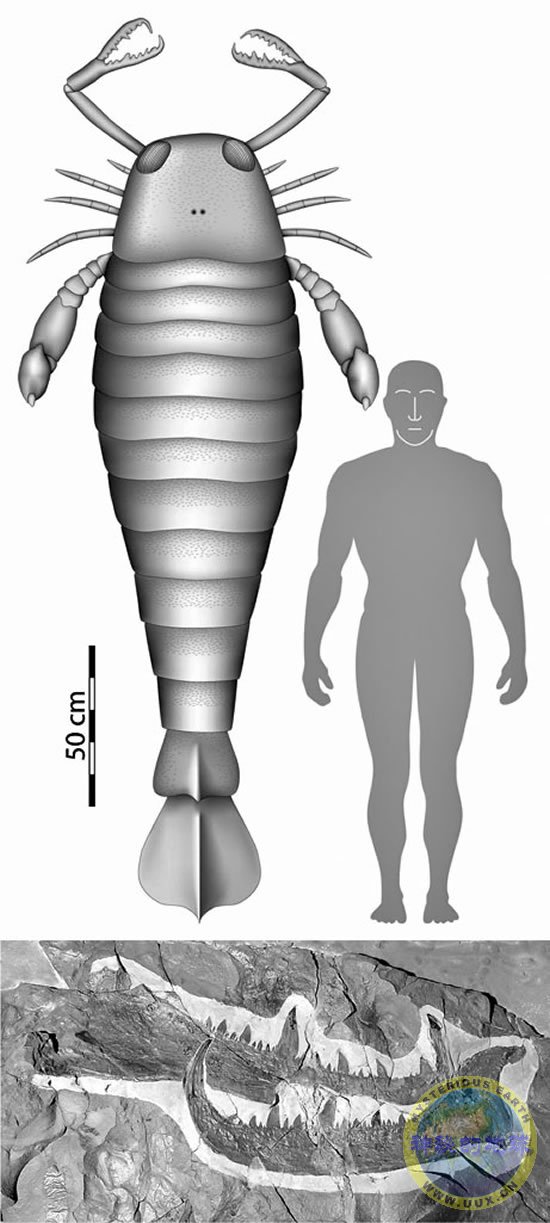Giant Sea Scorpion Discovered; Was Bigger Than a Man
Scientists say this 18-inch (46-centimeter) fossil claw (bottom) belonged to the world's largest known bug: an 8.2-foot (2.5-meter), 390-million-year-old sea scorpion called Jaekelopterus rhenaniae.
Illustration and photograph courtesy Biology Letters
James Owen
for National Geographic News
November 21, 2007
A fearsome fossil claw discovered in Germany belonged to the biggest bug ever known, scientists announced Tuesday.
The size of a large crocodile, the 390-million-year-old sea scorpion was the top predator of its day, slicing up fish and cannibalizing its own kind in coastal swamp waters, fossil experts say.
Jaekelopterus rhenaniae measured some 8.2 feet (2.5 meters) long, scientists estimate, based on the length of its 18-inch (46-centimeter), spiked claw.
The find shows that arthropods—animals such as insects, spiders, and crabs, which have hard external skeletons, jointed limbs, and segmented bodies—once grew much larger than previously thought, said paleobiologist Simon Braddy of the University of Bristol in the United Kingdom.
"This is an amazing discovery," Braddy said.
"We have known for some time that the fossil record yields monster millipedes, supersized scorpions, colossal cockroaches, and jumbo dragonflies," he added. "But we never realized, until now, just how big some of these ancient creepy-crawlies were."
The newfound fossil creature is estimated to be at least one and a half feet (46 centimeters) longer than any previously known prehistoric sea scorpion, a group called eurypterids.
Braddy and co-author Markus Poschmann of the Mainz Museum in Germany report the find in the latest issue of the journal Biology Letters.
Poschmann uncovered the fossilized claw in a quarry near Prüm in Germany.
Rock layers encasing it suggest the creature lived in a brackish coastal swamp or river delta, the researchers said.
Water Bug
Smaller sea scorpions are known to have crawled ashore to mate or shed their outer skins. But "there's no way this monster bug would have been able to do that, because it was just too big," Braddy said.
"Its legs were relatively flimsy compared to the size of its body," he added. Without water buoying the big beast up, its legs would have collapsed under the weight of its body, Braddy said.
The arthropod was top of the food chain, he said.
"They were cannibals but they also would eat some of the early armored fish that were around at the time."
Some researchers think that some primitive jawless fish evolved protective bony shields because of predatory pressure from sea scorpions, he added.
Though J. rhenaniae has been known for many years, no one realized the species grew so huge, according to paleontologist Paul Selden of the University of Kansas.
"It would pretty much have eaten anything smaller than itself," Selden said.
The animal's claws were armed with long sharp teeth that "would have grasped even a slippery fish."
Held at the ready on two long, folding arms, those claws would have been used to ambush prey, Selden said.
"I think they were designed for shooting out when close to prey, like the arms of a praying mantis," he added.
Eurypterids, the relatives of modern-day land scorpions and spiders, likely reached such massive sizes due to lack of competition from fish and other vertebrates—animals with backbones—study author Braddy said.
Top Predator
"The backboned animals hadn't stepped up a gear yet in their evolution, so they weren't any real threat to the arthropods," he said.
"When they did, that's when the arthropods had to downsize."
Jason Dunlop, arthropod curator at Berlin's Museum of Natural History, agrees.
"You didn't have so many jawed fish offering competition," Dunlop said.
"When fish evolve jaws during the Devonian period [416 to 359 million years ago]—afterwards the sea scorpion fossil record does tail off."
Biggest Bug
The new fossil represents the largest arthropod so far discovered, he added.
The next biggest fossil arthropods were massive millipedes that grew more than 2 meters (6.5 feet) long, Dunlop said.
The giant sizes of these and other land-dwelling prehistoric arthropods—including dragonflies with the same wingspans as seagulls—have been linked to increased levels of oxygen in the atmosphere.
But as sea scorpions were water animals, "atmospheric oxygen probably wouldn't have played such an important role," Dunlop said.
Eurypterids disappeared from the fossil record during the Permian extinction some 250 million years ago, when about 95 percent of marine species were wiped out.
The largest arthropods living today include lobsters and spider crabs, both of which would have been bite-size snacks to J. rhenaniae.












